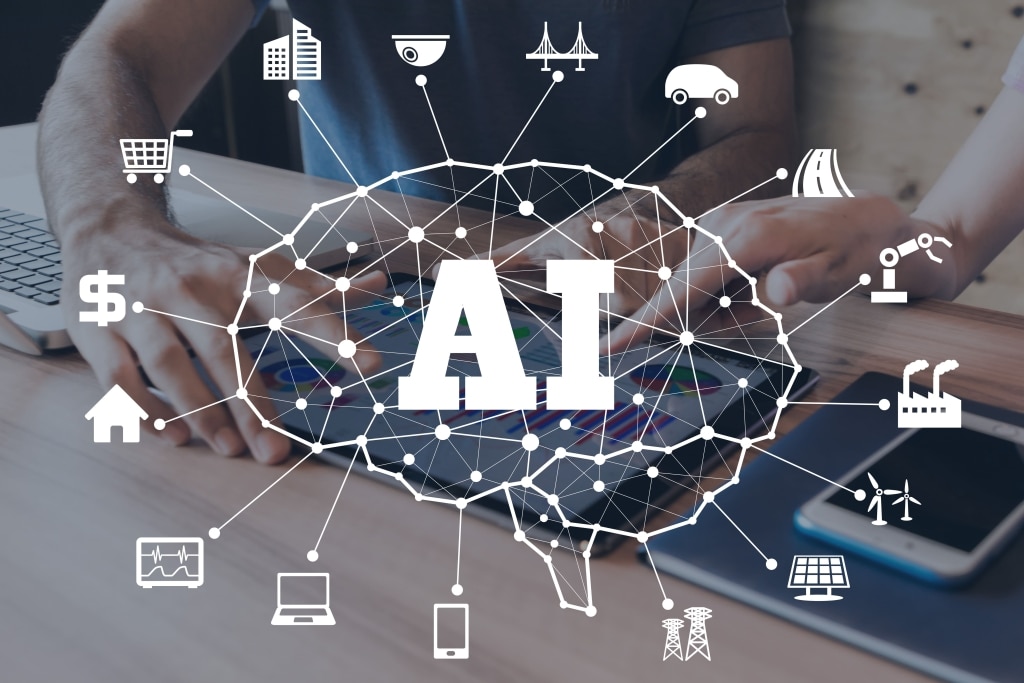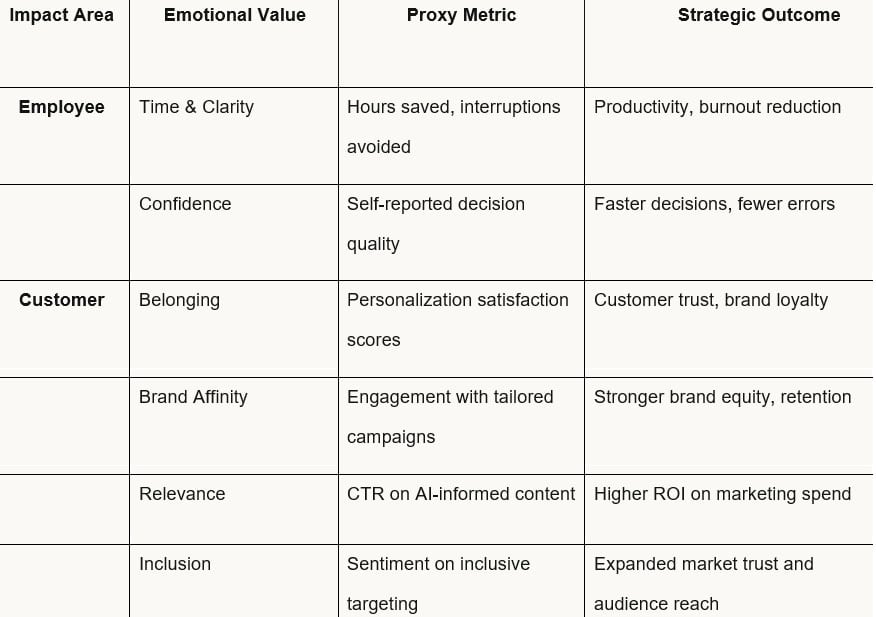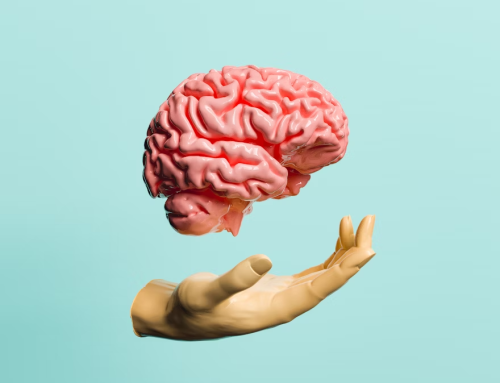
Artificial intelligence is reshaping business, but not only in the ways we typically measure. Most organizations still evaluate AI based on traditional ROI metrics: reduced costs, greater efficiency, and increased revenue. But in reality, AI’s most powerful impact may lie elsewhere: in the way it affects people’s feelings, decisions, and sense of connection.
AI’s return on investment isn’t just financial. It’s emotional—and it’s time we started measuring it.
The Human Dividend of AI
Inside the organization, AI tools are transforming the employee experience. They help draft reports, generate insights, summarize meetings, and automate routine communication. These capabilities don’t just improve workflow—they restore time, reduce stress, and boost confidence.
A 2025 study examining AI implementation in healthcare settings revealed that ambient AI tools reduced burnout rates among medical staff from 69% to 43% in just five weeks. Even more telling, 80% of physicians reported stronger interpersonal connections with patients when AI handled documentation, freeing them to focus on human interaction.
This emotional dividend extends beyond healthcare. According to a 2025 Forrester survey, 66% of HR and employee experience leaders reported increased employee satisfaction after adopting AI-powered HR solutions, with 72% seeing improved productivity. Organizations now deploy AI for around-the-clock support, reducing stress and enhancing work-life balance.
The Global Wellness Institute reports that “wellbeing intelligence” has become a core leadership competency for 2025, with forward-thinking organizations developing leaders who can navigate the human dimensions of technological transformation. These leaders excel at leveraging AI systems while cultivating environments where human potential thrives.
These aren’t just tools for execution—they’re tools for emotional resilience.
Personalized Experience as Emotional ROI
On the customer side, AI enables personalization at scale—think of Netflix recommendations, Amazon’s product suggestions, or Spotify’s custom playlists. These aren’t just clever features; they tap into something deeper: the need to feel seen.
Recent 2025 research demonstrates that AI-driven personalization significantly boosts both customer satisfaction and loyalty. A study of the telecom company Ooredoo found that customers who received personalized recommendations were more likely to make repeat purchases and develop a deeper emotional attachment to the brand. The study quantified that the perception and quality of AI-based personalization had a strong positive effect on loyalty (γ=0.201 and γ=0.242, both statistically significant).
The emotional impact is clear: a January 2025 McKinsey report found that 71% of consumers now expect personalized interactions, with 76% expressing frustration when these expectations aren’t met. Companies that get personalization right create significant value, with research showing personalized experiences can generate five to eight times the return on marketing spend.
Here, marketing plays a pivotal role. From tailoring content journeys to orchestrating messaging that adapts in real time, marketers are often the architects of these emotionally resonant experiences. AI may power the backend, but marketing shapes the perception. When a customer receives a message that reflects who they are—and not just what they’ve clicked on—that’s emotional ROI at work.
Navigating the AI-Human Balance: Will Emotions Still Matter?
As AI capabilities advance rapidly, executives face a pressing question: In a world where AI agents can handle increasingly complex tasks, does emotional connection still matter? The evidence suggests it matters more than ever.
Research from the 2025 Global Work Values Survey reveals a striking paradox: as AI automation increases, so does the premium consumers place on authentic human connection. Among 10,000 global respondents, 83% reported they would pay more for products and services from companies where they felt “emotionally understood”—up from 71% in 2023.
For employees, the picture is more nuanced. The 2025 Future of Work Report by Oxford Economics found that while AI will continue to transform job roles, companies that view AI solely as a replacement for human workers consistently underperform those using AI as an amplifier of human capabilities. Organizations taking the “augmentation approach” reported 41% higher innovation metrics and 37% greater market share growth.
The key insight is that emotional intelligence becomes more valuable, not less, as AI handles routine tasks. According to data from LinkedIn’s Global Talent Trends, jobs requiring high emotional intelligence saw 27% salary premiums in 2025, compared to 18% in 2023.
As one CEO of a Fortune 100 company put it: “We initially saw AI as a cost-saving measure. We now understand it’s a human amplifier. When we free our people from routine work, their creative and emotional capabilities create our real competitive advantage.”
This doesn’t mean all jobs are safe from automation. The World Economic Forum’s 2025 Future of Jobs Report estimates that while 85 million jobs may be displaced by AI and automation by 2027, 97 million new roles may emerge that are better adapted to the new division of labor between humans, machines, and algorithms. The key differentiator in these emerging roles? Human emotional intelligence that complements AI capabilities.
The Emotional ROI Matrix
To help leaders assess these less-visible benefits, we propose a new tool: the Emotional ROI Matrix. This framework captures the emotional and experiential value AI provides across employees and customers, and across operational and brand-facing outcomes.
These are not “soft” metrics. They are leading indicators of resilience, growth, and differentiation.

What We’re Still Missing: The Measurement Gap
Despite the clear emotional impact, few companies measure AI’s effect on employee well-being, customer trust, or creative potential. Most dashboards remain locked in lagging indicators—efficiency, clicks, churn.
The 2025 State of AI in Marketing report found that only 29% of marketers self-report “advanced” AI maturity, with the majority still relying on ad-hoc or individual applications. While 57% use generative AI for content creation, fewer than a third leverage it for hyper-personalization, workflow automation, or predictive optimization—powerful capabilities that could drive emotional value.
What’s more telling is that 96% of “very advanced” organizations measure the ROI of their AI investments compared to only 22% at the beginning stage. This measurement discipline correlates strongly with success.
To move forward, we need:
- Short employee pulse surveys on AI impact (e.g., “Has this tool helped reduce work stress?”)
- Customer sentiment analysis tied to AI-driven personalization
- Cross-functional KPIs that combine tech adoption with emotional metrics
Until we evolve our measurement systems, we will continue to underestimate AI’s real return.
The Call to Action
As AI becomes increasingly integrated into business operations, executives face a strategic imperative to balance automation with emotional intelligence. The data is clear: organizations that view AI merely as a cost-cutting tool will be outperformed by those who harness it to enhance human capabilities.
Forward-thinking leaders must now ask:
- Where in our customer journey does emotional connection create the most distinctive value?
- How can we deploy AI to handle routine tasks while elevating, not eliminating, human roles that require emotional intelligence?
- What metrics should we implement to track emotional ROI alongside traditional financial measures?
- How do we retrain and reskill our workforce to excel at the human elements that AI cannot replicate?
The next competitive frontier won’t be determined by who deploys AI most extensively, but by who deploys it most wisely. Companies that succeed will use AI to automate the routine while amplifying the emotional intelligence that creates true differentiation.
As one CHRO from a leading technology firm noted: “AI doesn’t diminish the importance of emotion in business—it highlights exactly where human connection matters most.”
That’s the future of competitive advantage in the AI era—and the most strategic leaders are already positioning for it.
References:
- Global Wellness Institute (2025): “Workplace Wellbeing Initiative Trends for 2025”
- Forrester (2025): “AI’s Impact on Employee Experience”
- McKinsey (2025): “Unlocking the Next Frontier of Personalized Marketing”
- Jasper (2025): “The 2025 State of AI in Marketing: Trends and Insights”
- Ooredoo Case Study (2025): “AI-Driven Personalization and Customer Loyalty”
- Emotional AI Market Research Forecasts Report (2025): “Focus on Customer Services and Enterprise Applications”


